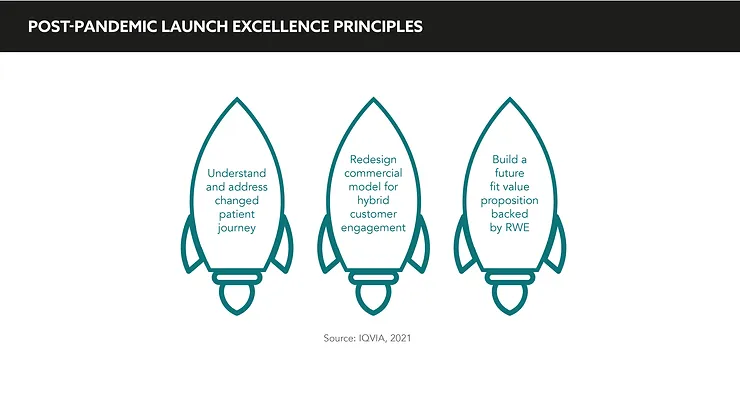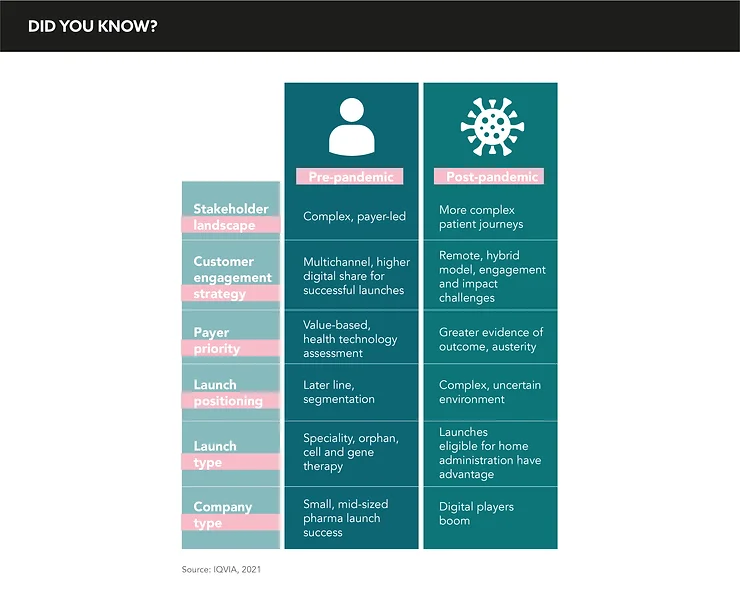Amidst an ever-changing launch landscape, the COVID-19 pandemic has entirely disrupted the pharmaceutical industry, encouraging adaptation for success. By understanding the transformed patient journey, leveraging digital campaigns, and innovating in healthcare marketing strategies, how can pharma find new avenues for launch success?
Words by Cheyenne Eugene
For the billionaires recently entering (and returning from) the stratosphere, their teams had years to prepare.
The process was meticulously orchestrated and their success was anticipated. Down here on the ground, and with COVID-19’s arrival, drug launch teams were blasted into the abyss, much like Bezos and Branson, but with little time to prepare for lift off. The criteria for a successful product launch has shifted and teams must fuel their rockets with agility and creativity, alongside current analytics.
Trends and transformations
Historically, drug launches have followed a few key trends: the early 2010s gave rise to the age of speciality, the mid 2010s saw dominance in hepatitis C launches, and the decade was drawn to a close with orphan drugs dominating the market. However, the past 18 months has seen unprecedented levels of transformation and even stagnation of the drug launch landscape.
Sarah Rickwood, Vice President, Europe, the Middle East and Africa Region, Marketing and Thought Leadership, IQVIA, describes the pre-pandemic process: “Launch campaigns have generally relied on a high level of face-to-face interactive time with healthcare professionals to get often complex messages across and to understand and build relationships.” Rickwood acknowledges that the most compelling impact of the lockdowns was that this type of communication diminished – and that, for the most part, it is likely to remain that way.
The transition to digital alternatives
As well as face-to-face interactions continuing to be replaced by digital alternatives, the pandemic brought other caveats for launch teams. During a time of uncertainty, HCPs are likely to default to existing treatments, rather than put their trust into novel products, meaning a more hostile environment for newly launched drugs.
On top of this, as a result of the pandemic, there is widespread underdiagnosis of certain, non-COVID-related, conditions. This has triggered speculation around whether there could be a backlog of non-COVID treatments post-pandemic, leaving less room for novel drugs and innovation to enter the shelves of the healthcare system.
Understanding how the patient journey to diagnosis and treatment has changed during the COVID-19 crisis is paramount for cultivating launch success in the post-pandemic environment.
Speaking at Cannes Lions Live 2021, Tamara Rogers, Chief Marketing Officer, GSK expands: “As marketers, we want to understand the whole person and how their condition affects them. [During the pandemic], we found that patients were reducing their experiences of life and connection-building… We also saw a significant change in people’s attitudes about their health.” Patient and HCP behaviour is revolutionising, particularly around autonomy over one’s health and convenience. “We’re now trying to think about how we can fulfil that need,” says Rogers.
Uncovering the new patient journey
In a post-pandemic world, the criteria needed for a novel drug to achieve orbit is going to change. The products that are predicted to be most successful are those that reduce face-to-face visits for patients, encourage self-treatment and administration in the home setting, and those which can adapt to the economic austerity exacerbated by the pandemic.
“When you’re faced with a completely novel situation, old solutions won’t work,” remarks Rickwood. “Companies that have succeeded so far were forced to become more creative in the face of an unprecedented environment.”
Rogers discusses the importance of brand-building while being receptive to consumers: “Marketing has become very data driven and that’s fantastic – you truly get to understand your audience and can be highly relevant, but it’s also driven an incredible amount of short-termism.”
She argues that the short-term optimisation of ‘buy it now’ makes it easy for competitors to intercept and may not be effective in the long-term. “That’s where purpose comes in,” says Rogers. “Connecting with values and what your consumer really wants.” This may take longer but studies suggest that building the emotional side of your brand could be a more effective long-term strategy and may also elevate short-term return-on-investment.
Adapting launch strategies post-pandemic
That said, a sudden burst of creativity is not as powerful as continuous innovation. Rickwood notes: “Companies that had already been more creative and cutting edge, in terms of their multichannel and digital campaigns, were more resilient and fared better.” She points out that “most commercially successful launches were also the most digital launches – in terms of share of first year promotional volume – even before the pandemic.”
Pre-pandemic, the recipe for success was relatively traced out and familiar, but as the smoke begins to clear from the past 18 months, the landscape has evolved and the rules behind a successful drug launch have changed.
There was no ‘T-minus’ countdown for the arrival of the pandemic and the disruption it brought to the industry. To navigate through the new climate, launch teams must embrace agility, creativity, and analytics to achieve and maintain HCP engagement, and, ultimately, get their product to the patient.











